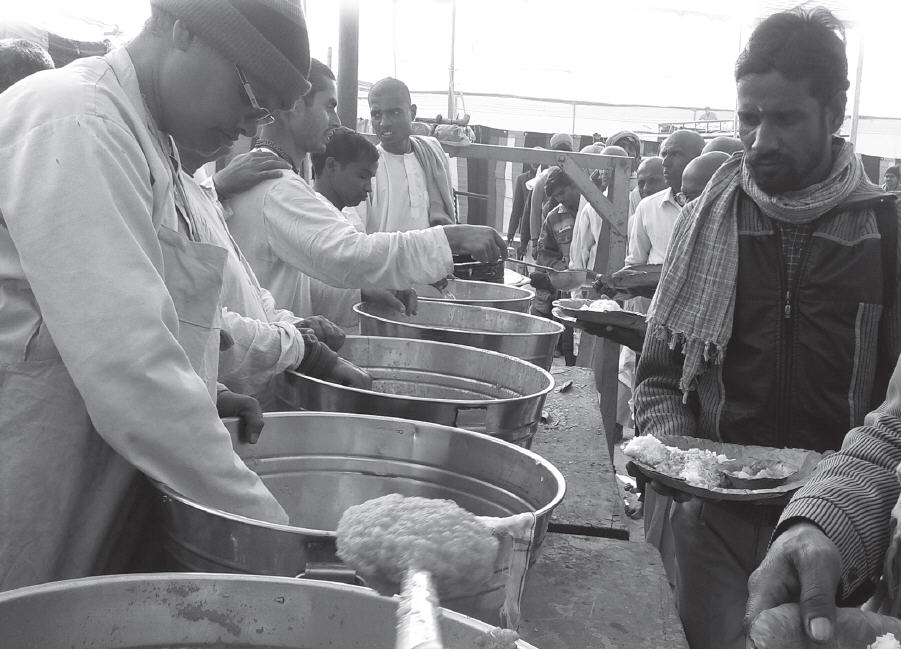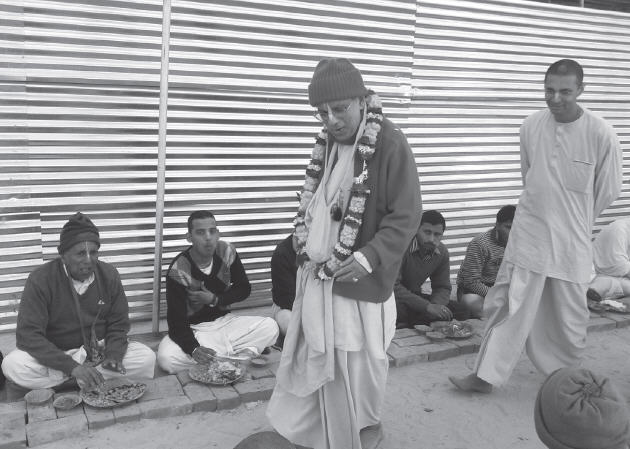Instead of heavenly nectar, at the recent Kumbha-mela ISKCON devotees relished a superior form of nectar that is not easily available.

Millions of pilgrims converged on Prayaga during the period between January 14 and March 10 to get a few drops of heavenly nectar. Impelled by faith, these people old, young, physically challenged, rich, poor – some how managed to come to this holy site in order to purify their human existence, despite the austere conditions.
As the story goes, in a by gone age the demons and the demigods once churned the Milk Ocean, out of which came celestial nectar that could award immortality. A fight ensued between the two parties over that pot of nectar, during which a few drops fell to earth at Allahabad (Prayaga), Haridvar, Ujjain, and Nashik. It is believed that one can reap the benefit of those nectarean drops by bathing at these spots during the Kumbha mela, For that reason, sadhus, who usually confine themselves to remote forests and mountain caves, come from all over the world to perform holy rituals in Prayaga, at the confluence of the rivers Ganga, Yamuna, and the subterranean Sarasvati
ISKCON at Kumbha-mela
Srila Prabhupada and his Western disciples attended the Ardha Kumbha-mela in 1971 and the Purna Kumbha-mela in 1977. He spent his days preaching to guests and encouraging his disciples to hold large chanting festivals and distribute thousands of books. During that time, Srila Prabhupada said, "Although most of the pilgrims come for liberation, the devotees have come only to preach. Being engaged in Krishna's service, we are already liberated; we are not interested in liberation. We have come to preach devotional service."
Preaching devotional service means distribution of transcendental literature, holding mass harinama-sankirtana, and distribution of krishna-prasada. These were the main objectives of the ISKCON tent at Kumbha-mela in Srila Prabhupada's presence, and they remain ISKCON's objectives more recently.
The devotees from ISKCON Delhi distributed thousands of copies of Bhagavad-gita As It Is and other books of Srila Prabhupada, And the padayatra devotees, headed by Acarya Dasa, regularly went out on harinama-sankirtana in order to distribute the divine nectar of Krishna' s holy names. This article will focus in particular on the services of the kitchen team that provided tasty and nutritious prasada for all the devotees and guests.
Kitchen Setup and Prasada Distribution
The first major challenge was to transport tons of utensils and cooking vessels from Mumbai to Allahabad. Octroi and toll nakas on the highways demand heavy charges to allow vehicles to pass, so a devotee dressed in devotional attire would always accompany our vehicles. Seeing him, the traffic authorities would understand the religious purpose and usually wouldn't give much trouble. Sometimes they would even give free passage.

At the Kumbha-mela site, the thousands of pilgrims we were expecting to visit us every day. The ISKCON kitchen was distinct from all other kitchens because of our superior efficiency, technology, cleanliness, and the quality of prasada.
We made the best use of technology in Krishna's service. Most vegetables were cut, peeled, and mashed using automated machines. An automatic chappati-making machine enabled us to cook a thousand chappatis per hour. Huge vessels were lifted using cranes and then transported to the distribution site on rail lines built specially for this purpose. This automation made the work so much easier and faster. There were also two tandoor burners, 8-10 big burners, and machines for kneading and cutting the dough. There were a total of 40 crew members in the kitchen, including devotees from Mumbai, Belgaum, and other ISKCON centres, who all came to render devotional service despite the harsh weather and austere living conditions.
Usually those who distribute prasada at Kumbha-mela do so in an open area outside their camp. Pilgrims stand in a queue, get a plate, and then sit anywhere they can find to eat. At our kitchen, however, we would welcome the pilgrims inside our tent and have them sit comfortably in orderly rows. Devotees would then personally serve each item to each pilgrim. A full meal consisted of chappatis, tandoori roti, two vegetable dishes, daf, rice, salad, farsan (fried items like vada or bhajiya), and a sweet. The menu was different every day. Every day more than 5000 people were served. On special bathing days, the number doubled – 10,000 plates! More than 200,000 people took prasada during the entire two month period. Impressed with the volume, efficiency, and quality of our efforts, many television and newspaper channels covered our cooking and distribution services.
Although free food distribution was common throughout the Kumbha-mela grounds, getting such a full multi-course meal was otherwise unheard of. Almost every pilgrim appreciated the quality of prasada and service provided at the ISKCON camp. One Mexican couple, upon learning about us, would daily walk a 10-km stretch from across the Ganga in order to get prasada at our camp. The Assistant District Magistrate of Allahabad had nothing but praise for our team. He said, "Even my wife cannot cook such nice preparations that I am tasting here." And, seeing the devotion and service attitude of the ISKCON devotees, the head priest of Tirupati Balaji temple performed the kalyanam (marriage) ceremony of Balaji and Padmavati in our camp and later enjoyed the food.
Many ISKCON leaders and other devotees, too, expressed their deep satisfaction upon seeing the quality of service. Several devotees commented that Srila Prabhupada must have indeed been pleased to see his desires fulfilled.
Experiencing the Real Nectar
The Sahi-snan, or Royal Bathing Days, are the highlights of Kumbha-mela. These dates have special significance, since the celestial nectar is said to be most easily accessible to those who bathe on these days. Many of the ISKCON devotees involved in kitchen services missed the opportunity to bathe on these days. In fact, some did not get to bathe in the river at all during the entire period of Kumbha-mela. However, not one devotee regrets it, because we were too busy tasting the highest nectar: the nectar of service to the Vaishnavas. Since devotional service to Krishna awards the highest liberation of eternal blissful life, we did not worry much about bathing at the Triveni-sangam. Moreover, from a practical point of view, we didn't want to take chances with our health. Bathing at the Sangam in extreme cold might make us sick, and that would have disrupted our services inside the camp, thereby affecting thousands of devotees and pilgrims. We decided to sacrifice the sacred bath for a higher cause.
Damodara Dasa has done his post graduation in engineering from IIT Bombay. He has helped many ISKCON centers set up big kitchens for mass cooking. He was instrumental in getting ISO certification for the kitchen setup of ISKCON Chowpatty in Mumbai.
Kalpana Kulkarni works as the All-India Training Coordinator for Trade Wings Institute of Management Ltd. She has written several study books for the Institute on travel, tourism, and hospitality.
